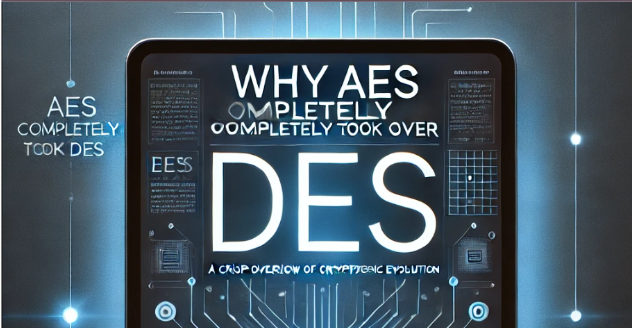Why AES Completely Took Over DES: A Crisp Overview
 Chitraksh Gupta
Chitraksh Gupta
In the world of cryptography, the transition from the Data Encryption Standard (DES) to the Advanced Encryption Standard (AES) marks a significant leap in data security. While both algorithms have played crucial roles in protecting sensitive information, AES has overwhelmingly taken the lead. Here's why.
1. The Weaknesses of DES
a. Key Length Vulnerability
DES uses a 56-bit key, which was robust in the 1970s. However, with modern computing power, it has become vulnerable to brute-force attacks. Simply put, it's possible to crack DES by trying every possible key, and today’s computers can do this in a matter of hours.
b. Block Size Limitation
DES operates on a 64-bit block size, which, while once sufficient, is now considered too small. This limitation increases the risk of pattern repetition in encrypted data, making it easier for attackers to exploit.
c. Speed and Efficiency
DES is relatively slow compared to modern algorithms. Its design is not optimized for current hardware, making it less efficient in both software and hardware implementations,While DES was specifically designed for hardware systems because it efficiently maps bits and performs XOR operations in hardware.
2. The Advantages of AES
a. Robust Key Lengths
AES supports key lengths of 128, 192, and 256 bits. This provides significantly stronger security than DES. Even the smallest key size in AES is exponentially more secure than DES’s 56-bit key.
b. Larger Block Size
AES uses a 128-bit block size, reducing the risk of repetition and making the encryption much more secure against various types of cryptographic attacks.
c. Enhanced Performance
AES is designed to be fast and efficient on both hardware and software platforms. Its structure allows for parallel processing, making it suitable for modern computing environments. This speed is crucial for applications requiring rapid encryption and decryption, such as secure communications and large-scale data storage.
d. Flexibility and Standardization
AES is highly versatile, supporting various key sizes and block sizes. It’s also widely standardized and adopted across industries, making it the go-to choice for securing everything from personal data to government secrets.
3. Why AES Took Over
The transition from DES to AES was driven by the need for stronger, faster, and more secure encryption. DES served its purpose well during its time but could not keep up with advancements in cryptanalysis and computing power. AES, with its enhanced security, speed, and flexibility, has become the industry standard, replacing DES in virtually all applications.
4. Conclusion: The Future of Cryptography
As we move further into the digital age, the importance of strong encryption like AES cannot be overstated. While DES was groundbreaking in its time, AES represents the future of secure communications, standing as a testament to the ongoing evolution in the field of cryptography.
Subscribe to my newsletter
Read articles from Chitraksh Gupta directly inside your inbox. Subscribe to the newsletter, and don't miss out.
Written by
